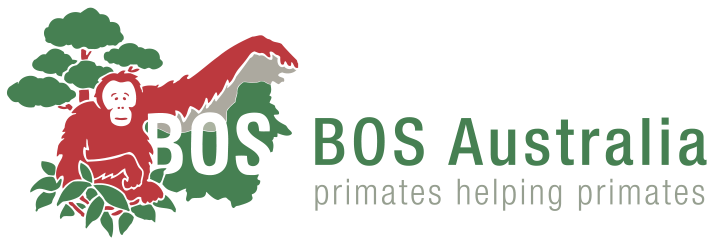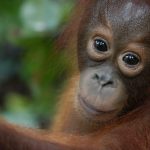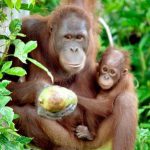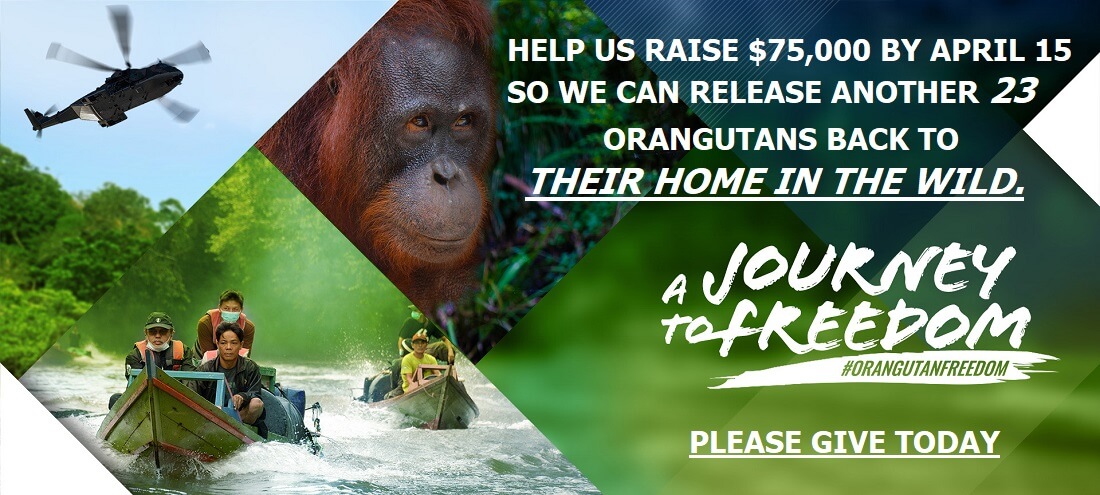“ONE OF THE MOST BEAUTIFUL PLACES IN THE WORLD”

One of the largest rainforests in Asia is located in Kalimantan, the Indonesian part of Borneo. Within it lies the Kehje Sewen Forest, where we release rehabilitated orangutans. To give you a glimpse of the beauty and importance of the Kehje Sewen Forest, we have talked to Devi and Rofinus, both members of the Post-Release Monitoring team. Devi works at Camp Lesik in the north and Rofinus at Camp Nles Mamse in the south.
What does the rainforest mean to you?
Devi: As the name implies, this type of forest has high rainfall, which is relatively consistent throughout the year. The rainforest, for me, is proof that there is harmony in nature. When the forest is left alone, and everything is allowed to carry out its function, it creates an ecosystem that is plentiful with life and unrivalled by all others. The biodiversity within supports one another, and, together, they support a high level of productivity, which in turn contributes back to the rich forest biodiversity. This means that rainforests play a very important role on Earth, both, ecologically and as one of the largest producers of environmental services on this planet.
Rofinus: In my opinion, the rainforest is one of the most beautiful places in the world. It is a place that makes me feel both calm and excited. There are so many different animals and a huge array of plants, many of which have countless practical uses and medicinal properties. Simply walking through the rainforest, taking in all of the plants and life is just an amazing sight to behold to see.
What is the Kehje Sewen Forest like?
Devi: The Kehje Sewen Forest has a very beautiful landscape, covered in towering hills, flowing rivers, terraced canopy cover, and a variety of fauna and flora. The Kehje Sewen Forest provides a glimpse of the beauty of natural forests when they are left to thrive and grow. The number of lianas and large trees, and moss growing on the ground and rocks, is proof that this forest is growing well in a sustainable manner.
Rofinus: In my opinion, the Kehje Sewen Forest is in quite good condition. There are still a lot of tall trees in the forest, and the natural conditions are favourable.
What distinguishes the Kehje Sewen Forest from other forests?
Devi: The Kehje Sewen Forest has many unique characteristics. The river system, a very important source of life in the forest, has shaped the steep contours of the area. Covered in hills and valleys, the resulting scenery is one of sheer beauty. From a distance, you can see the opposite hill. Sometimes you can see monkeys having fun there, playing in the trees. Also, you get to see hornbills building their nests and watch eagles in flight. The steep contours provide a comfortable habitat for some unique mammals, such as wild boars, deer, and sun bears. The Kehje Sewen’s high level of biodiversity makes it one of the most important forests in the region.
Rofinus: In my opinion, the abundance of food and water sources is what sets this forest apart from the rest.
Can you describe the experience of patrolling for orangutans in the Kehje Sewen Forest?
Devi: Patrolling requires a lot of effort. Every day brings new challenges, and you have to keep your spirits up. There is a sense of enthusiasm when the day’s activity involves patrolling a transect. Many questions start popping up in your mind: Will I spot any orangutans today? Will I get to take photos of other animals? What’s the weather like, and is it going to affect our monitoring? These questions get me even more excited about the patrol to come. At the start of a patrol, the contours of the landscape can sometimes be a bit hard to negotiate. It doesn’t take long for your legs to tire and for you to be in desperate need of a break. But when you stop to take a breather, an interesting animal might suddenly appear, which then drives you to keep patrolling.
Anxiety can also disturb a patrol, especially when it suddenly rains as night is falling. As you probably would expect, the tropical, wet conditions mean that we often encounter landslides, fallen trees, and flooded rivers. However, these obstacles fail to discourage us. We always seem to find a way out of the difficulty so we can keep patrolling without compromising the safety of our team members.
Rofinus: My experiences here have been so great and varied, even from humble beginnings in just learning about the types of plants, animals, birds, and orangutans. I used to think orangutans were simple animals, nothing like human beings, but now I know that orangutans are very similar to humans, and I feel sorry for all that our species has put them through.
What are the challenges of living and working in the Kehje Sewen Forest?
Devi: Here, you have to expect the unexpected because anything can happen. As humans living in the era of the internet, living in the forest presents old challenges that many of us are not used to in our modern, connected world. It can be very difficult to access information that many of us take for granted. As you can imagine, the internet network here is unstable; we have to be patient when communicating with people outside of the forest, especially if we want to keep in contact with our families and friends. Whilst conducting our activities in the forest, we also have to stay vigilant of the many dangers that we can encounter at any given time. Due to the forest’s high level of biodiversity, there are many wild animals and poisonous plants. There are venomous snakes, sun bears, clouded leopards, and even rehabilitated orangutans that can be unpredictable at times. This means that we must maintain a high level of awareness wherever we are and with whatever we are doing, as the camp is quite far from the nearest medical centre. In addition to the forest’s animals, we also need to be mindful of environmental factors, as the weather can change quickly and drastically. For example, heavy rain can cause sudden landslides and flooding rivers. Strong winds can bring down tall trees. We have to be alert and careful because accidents can happen at any time.
Rofinus: There is a whole combination of factors to consider: the constraints of limited communication, the extreme terrain conditions, and challenges of natural events such as heavy rainfall, floods, and fallen trees.
Why is it important to preserve the Kehje Sewen Forest?
Devi: The first time I saw orangutans in the wild was in this forest, and orangutans are just one of the many fascinating animals I have encountered here. There are also many types of birds that have stunning colour patterns and are unique from other species. On patrol, you often don’t notice the scorching heat of the sun because the dense canopy helps to create a different microclimate. You feel cooler and more comfortable as you enter the forest. The Kehje Sewen Forest also has many rivers flowing through it, and, like many other rainforests, it too has an important hydrological role in regulating the water that allows for life to flourish here. After all, water is the source of life – we can’t live without it! This is why it is vital to preserve the rainforests we have, like the Kehje Sewen Forest.
Rofinus: Maintaining the condition of the existing forest is vital: We want to ensure that it doesn’t flood and that there are no landslides so that the communities around the forest are safe.
If you would like to help us secure orangutan homes, please consider giving to our Tax Appeal by 30 June and help us reforest 60 hectares of vital orangutan habitat for generations to come. Have your gift matched today and double your impact instantly!








